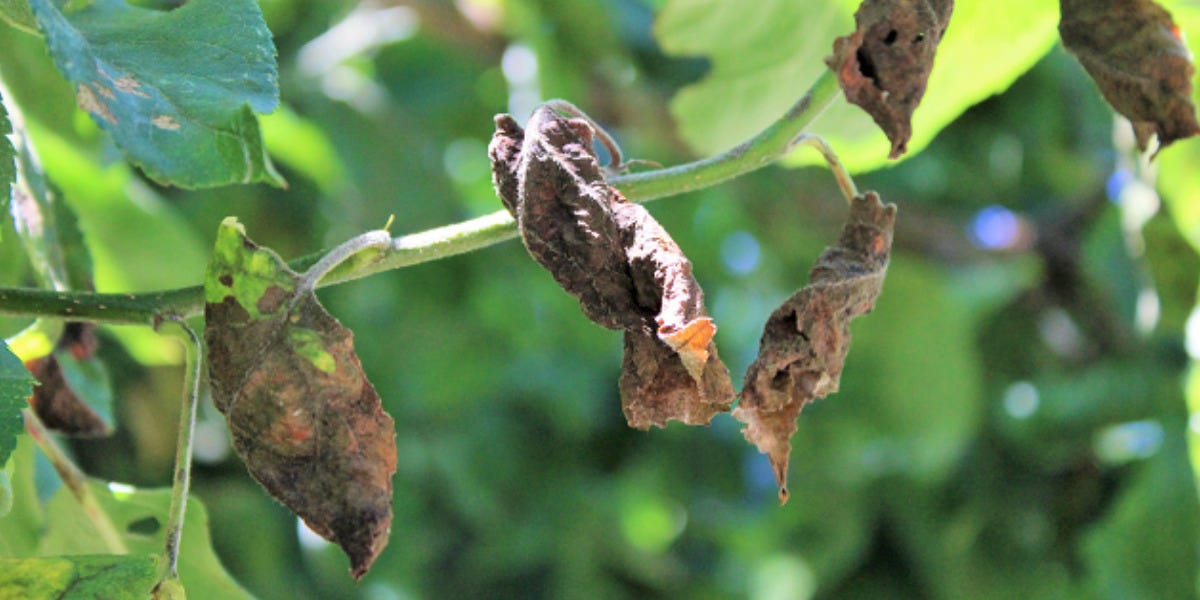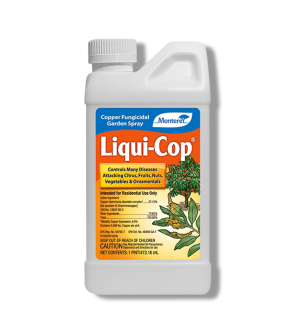Fire Blight
Most Effective Products
Fire Blight Control: How to Get Rid of Fire Blight
This page is a general DIY guide for controlling fire blight. Using the products and methods suggested you will get control of fire blight infestations. Follow this DIY article and use the recommended products, and we guarantee 100% control of fire blight.
Fire blight, caused by the bacterium Erwinia amylovora, is a common and destructive bacterial disease that attacks over 75 species of fruit trees and other ornamental plants. This disease is often influenced by the seasons warm weather in conjunction with wetting events.
The pathogen gets its name from the damage it causes: it will look like someone has set the tips of plants on fire. Typically, fire blight starts with the blossoms, flowers, or leaves then moves into the twigs, branches, and trunks of plants.
These cankers will ooze and allow it to be transmitted to each plant by rainfall, wind, or traveling insects. Once established, it can greatly impact the value and life of desired foliage. To stop fire blight from attacking your plant then quickly follow the recommended steps and products suggested in this DIY guide.
Identification

Before proceeding with a treatment program, you will need to be certain that you are dealing with a fire blight infestation. Careless identification can lead you to using the wrong treatment methods, which can be a waste of your time and money. Below are some common characteristics to know what fire blight looks like:
- First signs of fire blight are watery, light tan to reddish-brown ooze cankers that appear sunken. Parts of the plant where these cankers appear may be cracked or peeling.
- As fire blight develops, it will cause sudden wilting or dying of leaves, branches, twigs, fruit, or blossoms giving it the appearance of having been scorched by fire. Tips of branches, twigs, and leaves will often droop and bend into an 180 degree angle, forming a shepherds crook. The blossoms and leaves tend to stay on foliage instead of falling.
- Infected fruit will turn brown or black in color then eventually shrivel up causing it to become mummified.
Use the image and description above to help you properly identify fire blight on your property. If unsure, contact us and send a photo of the plant symptoms through email or in-person at one of our store locations to help you identify the disease and suggest treatment options.
Inspection

Once confirmed that are you dealing with fire blight, you can move on to inspection. During this phase, you will locate all areas where fire blight is developing and observe the conditions allowing it to thrive. This information will help you in knowing where to focus your fungicide applications.
Where to Inspect
Fire blight will develop in the rose family of plants such as apple, pear, crabapple, hawthorn, cotoneaster, mountain ash, firethorn, quince, rose, pyracantha, and spirea.
What to Look For
Fire blight requires warm temperatures above 70 degrees Fahrenheit and high humidity to multiply thus seeing outbreaks occur in warm moist conditions. Typically, these conditions are most noticed in the spring season.
Should fire blight appear it will cause flowers, shoots, or young fruit to shrivel and turn brown to black.
First signs of an early infestation will only appear on flowers or flower clusters, then extend into the twigs, branches, and leaves causing them to wilt and form a crook at the end of each infested plant part.
Treatment
After identifying fire blight and inspecting which plants are effected, you can begin to treat foliage. Be sure to wear the proper personal protective equipment (PPE) before handling or applying any type of product.
When temperatures have exceeding 70 degrees Fahrenheit and other environmental conditions such as rainfall or hail are witnessed you may want to apply a fungicide.
Pesticides that are copper-based or contain the active ingredient Streptomycin are most effective against fire blight. Keep in mind the control of fire blight is based on prevention, and not many fungicides are labeled to cure active infestations.
Step 1: Prune
 Be vigilant and always practice basic plant maintenance like pruning.
Be vigilant and always practice basic plant maintenance like pruning.
Early pruning of infected plant parts can help to halt the spread of fire blight. This will also help to avoid the spread to other nearby plants through watering, wind, or insect activities.
Prune at least 12 inches below the diseased area, but avoid excessive pruning as this can cause additional stress to plant.
When pruning is complete, be sure to clean pruning tools to avoid accidentally spreading this disease to the next plant.
Step 2: Apply Fungicide
 Ensure the disease is controlled by applying a fungicide when fire blight symptoms first appear or as soon as they develop.
Ensure the disease is controlled by applying a fungicide when fire blight symptoms first appear or as soon as they develop.
Liqui Cop Copper Fungicide is a weather resistant copper-based fungicide that will help to control fire blight outbreaks in apples, pears, and quince.
Copper pesticides like Liqui Cop Copper Fungicide are considered preventative, not curative of plant diseases.
Determine how much Liqui Cop Copper Fungicide to use by measuring the square footage of the treatment area. To do this, measure the length and width of the treatment area in feet then multiply them together (length X width = square footage).
To control fire blight in apples, pears, and quince use 1/2 to 1 tsp. of Liqui Cop Copper Fungicide per gallon of water.
We recommend mixing and applying the product with a hose-end sprayer to easily treat elevated heights such as trees.
Apply at 10% bloom and repeat at 5 – 7 day intervals during the bloom period.
Mix specified rate in 1 gallon of water and apply 3 gallons of mixed solution to a small tree or bush, 6 gallons of mixed solution to a medium size tree, or 9 gallons of mixed solution to a large tree.
Thoroughly spray tree to point of runoff, including upper and lower surfaces of foliage. Do not overspray.
Prevention
 Once fire blight has been controlled, you will need to take on some preventative measures to stop fire blight from returning. Follow these preventative practices to keep fire blight away from desired plants:
Once fire blight has been controlled, you will need to take on some preventative measures to stop fire blight from returning. Follow these preventative practices to keep fire blight away from desired plants:
- All plant material next to infested plants should be immediately removed from the area when fire blight is first noticed. Only return these plants to infested sites when fire blight has been eliminated.
- Improve overall watering of trees and plants by adjusting irrigation to no more than once a week with an inch of irrigation. To avoid over-watering in trees, we recommend using either the Solutions Tree Watering Ring which delivers 15 gallons of water slowly to trees or the Solutions Tree Watering Bags which slowly delivers 20 gallons of water. Use either of these products on trees that are 1 to 8 inches in trunk diameter and have branches that are at least 25 inches from the ground or higher. To use the Solutions Tree Watering Rings, place no more than 1 product around the base of each tree. Place 1 Solutions Tree Watering Bag around trees with a diameter of up to 3 inches. Zip 2 of the Solutions Tree Watering Bags together for trees 4 to 8 inches in diameter. For both of these products you will simply open the seal and insert the hose until the bags are full.
- Retreat foliage that was previously infested as well as new vegetation with Liqui Cop Copper Fungicide. Apply this product when plants are showing 10% bloom and reapply every 5-7 days during the plants bloom period to prevent and control fire blight infestations. Mix 1/2 to 1 tsp. of Liqui Cop Copper Fungicide per gallon of water to control fire blight in apples, pears, and quince. After the specified rate has been mixed with 1 gallon of water you can then apply 3 gallons of mixed solution to a small tree or bush, 6 gallons of mixed solution to a medium size tree, or 9 gallons of mixed solution to a large tree.
Key Takeaways
What is Fire Blight
- Fire blight is a contagious bacterial disease that causes stunting and death of branches and entire rose family plants.
How to Get Rid of Fire Blight
- To control fire blight infestations, you will first need to prune away parts of the plant that are infested. Cut at least 12 inches into health wood that is beneath the end of the fire blight infestation. Next, we recommend applying Liqui Cop Copper Fungicide.
Preventing Fire Blight Reinfestations
- Prevent fire blight from returning to plants by adjusting watering practices, removing healthy plants away from previous infested sites, and on-going applications of Liqui Cop Copper Fungicide.












































































































































































































































































































































































































































































































































